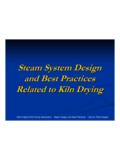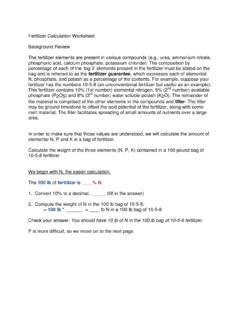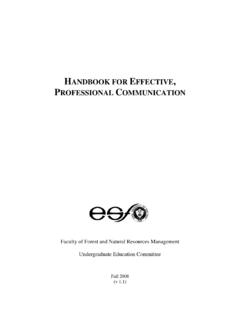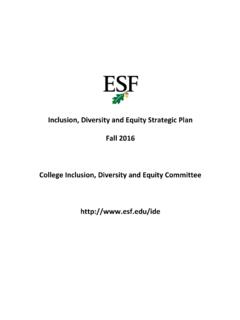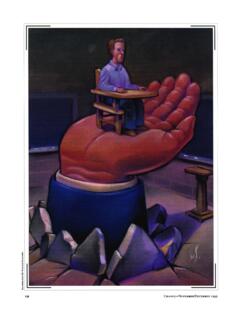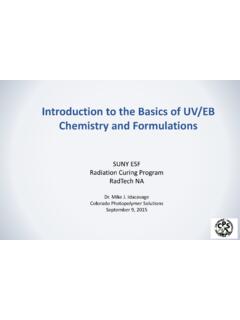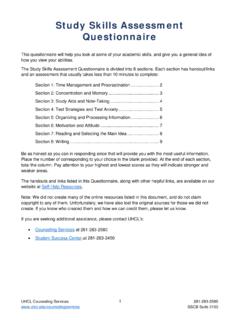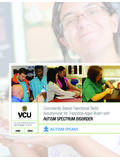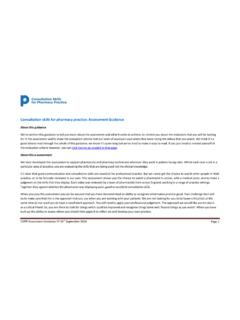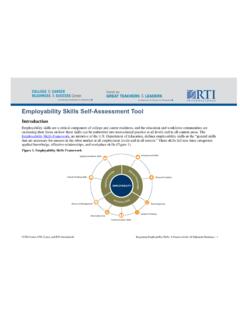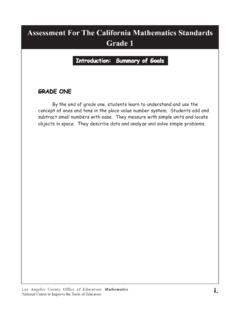Transcription of Classroom Assessment Practices and Teachers’Self …
1 APPLIED MEASUREMENT IN EDUCATION, 16(4), 323 342 Copyright 2003, Lawrence Erlbaum Associates, Assessment Practices andTeachers Self-Perceived Assessment SkillsZhicheng Zhang Fairfax County Public Schools Judith A. Burry-StockThe University of AlabamaThis study investigates teachers Assessment Practices across teaching levels andcontent areas, as well as teachers self-perceived Assessment skills as a function ofteaching experience and measurement training. Data from 297 teachers on the Assessment Practices Inventory were analyzed in a MANOVA design.
2 As gradelevel increases, teachers rely more on objective tests in Classroom Assessment andshow an increased concern for Assessment quality (p< .001). Across content areas,teachers involvement in Assessment activities reflects the nature and importance ofthe subjects they teach (p< .001). Regardless of teaching experience, teachers withmeasurement training report a higher level of self-perceived Assessment skills in us-ing performance measures; in standardized testing, test revision, and instructional improvement; as well as in communicating Assessment results (p<.)
3 05) than thosewithout measurement training. The implications of the results for measurementtraining are also discussed. Classroom Assessment has received increased attention from the measurementcommunity in recent years. Since teachers are primarily responsible for evaluatinginstruction and student learning, there is a widespread concern about the qualityof Classroom Assessment . Literature on Classroom Assessment has delineated the content domain in which teachers need to develop Assessment skills ( , Airasian, 1994; Carey, 1994; O Sullivan & Chalnick, 1991; Schafer, 1991; Stiggins, 1992, 1997).
4 The current consensus has been that teachers use a varietyRequests for reprints should be sent to Zhicheng Zhang, Office of Program Evaluation, Depart-ment of Educational Accountability, Fairfax County Public Schools, Leis Instructional Center, 7423 Camp Alger Ave., Falls Church, VA 22042. E-mail: Assessment techniques, even though they may be inadequately trained in certainareas of Classroom Assessment (Hills, 1991; Nolen, Haladyna, & Haas, 1992;Plake, 1993; Stiggins & Conklin, 1992). Less researched, however, is how teach-ers perceive their Assessment Practices and Assessment skills .
5 This study seeks toexpand the current research on Classroom Assessment by examining teachers as-sessment Practices and self-perceived Assessment skills in relation to content area,grade level, teaching experience, and measurement LITERATUREC lassroom AssessmentClassroom Assessment embraces a broad spectrum of activities from constructingpaper-pencil tests and performance measures, to grading, interpreting standard-ized test scores, communicating test results, and using Assessment results in deci-sion-making. When using paper-pencil tests and performance measures, teachersshould be aware of the strengths and weaknesses of various Assessment methods,and choose appropriate formats to assess different achievement targets (Stiggins,1992).
6 Test items should match with course objectives and instruction to ensurecontent validity (Airasian, 1994), reflect adequate sampling of instructional mate-rials to improve test reliability, and tap higher-order thinking skills . In perform-ance Assessment , validity and reliability can be improved by using observable andclearly defined performance tasks (Airasian, 1994; Baron, 1991; Shavelson, Baxter, & Pine, 1991; Stiggins, 1987), detailed scoring protocols, multiple samplesof behaviors evaluated by several judges (Dunbar, Koretz, & Hoover, 1991), andrecording scoring results during Assessment (Stiggins & Bridgeford, 1985).
7 Teachers should be able to revise and improve teacher -made tests based on teststatistics and item analysis (Carey, 1994; Gregory, 1996).Grading and standardized testing are two important components of classroomassessment. Since grade-based decisions may have lasting academic and socialconsequences (Messick, 1989; Popham, 1997), teachers should weigh assessmentcomponents according to instructional emphasis (Airasian, 1994; Carey, 1994;Stiggins, Frisbie, & Griswold, 1989) and base grades on achievement-related fac-tors only.
8 Grading criteria should be communicated to students in advance and im-plemented systematically to handle regular as well as borderline cases (Stiggins et al., 1989). Nonachievement factors such as effort, ability, attitude, and motivationshould not be incorporated into subject-matter grades because they are hard to de-fine and measure (Stiggins et al., 1989). In terms of standardized testing, teachersshould avoid teaching to the test (Mehrens, 1989), interpreting test items, and giv-ing hints or extra time during test administration.
9 Teachers should appropriatelyinterpret test scores and identify diagnostic information from test results about instruction and student learning (Airasian, 1994).324 ZHANG AND BURRY-STOCKC ommunicating Assessment results and using Assessment information in deci-sion-making constitute two other aspects of Classroom Assessment . To communi-cate Assessment results effectively, teachers must understand the strengths andlimitations of various Assessment methods, and be able to use appropriate assess-ment terminology and communication techniques (Schafer, 1991; Stiggins,1997).
10 Specific comments rather than judgmental feedback ( , fair ) are rec-ommended to motivate students to improve performance (Brookhart, 1997).When using Assessment results, teachers should protect students confidentiality(Airasian, 1994). Teachers should also be able to use Assessment results to makedecisions about students educational placement, promotion, and graduation, aswell as to make judgment about class and school improvement (Stiggins, 1992).In 1990, the American Federation of Teachers (AFT), the National Council onMeasurement in Education (NCME), and the National Education Association(NEA) issued Standards for teacher Competence in Educational Assessment ofStudents.
